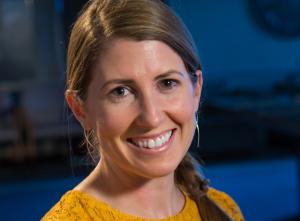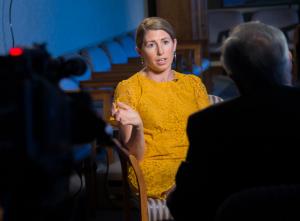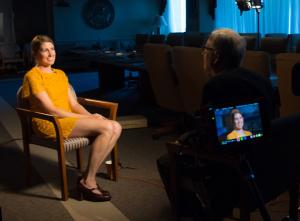VP, New York Energy Manager
PUF's Steve Mitnick: You're a vice president at the New York Energy Manager. Tell me what you do at NYPA.

Emilie Bolduc: The New York Energy Manager is the customer digitization of NYPA. We're taking our customer data, but of course this is not new information. We've had electric meters taking in energy data since we started generating electricity and using it for billing purposes.
Now we're using it in a new way, to understand how our customers are actually consuming their energy. We can then show that to them in ways that show historical trends. We can show them where there are opportunities to really reduce their energy based on this data. It's completely innovative.
Rather than just having a bill and seeing your data, now you can see your data and do something about it. Change your behavior and change that consumption.
It's a software platform that's cloud-based that our customers can access from their sites. They can access it on their mobile app. Anywhere they are, they can see what their building is consuming.
 Emilie Bolduc: What we’re doing with New York Energy Manager is giving our customers a tool to take control of their energy.
Emilie Bolduc: What we’re doing with New York Energy Manager is giving our customers a tool to take control of their energy.
PUF's Steve Mitnick: Where do you fit in?
Emilie Bolduc: We have developed this platform, and we've been using it for about two years. Right now, all it is showing is this data, and we're giving consumers insight.
But there's so much more it can do. With the way the market's changing, with the way that renewables are entering the grid, our customers are going to start generating more energy, as well as using it.
We want to be that interface for them. We want them to come to the New York Energy Manager and see what they're consuming, and what they're producing. We want them to understand what the market prices are.
 Emilie Bolduc: The New York Energy Manager is really going to be more of a distributed energy resource service marketplace, more integrated. We’ll be using the data, setting them up with these services, and then tracking that performance so it’s continuously in a loop, back to them.
Emilie Bolduc: The New York Energy Manager is really going to be more of a distributed energy resource service marketplace, more integrated. We’ll be using the data, setting them up with these services, and then tracking that performance so it’s continuously in a loop, back to them.
We want to tie them to different services to help them reduce that energy, or sell it into the marketplace to help them generate revenues. We want to truly be an all-encompassing energy manager for them to access digitally.
I'm taking it from NYPA 1.0 to that next vision, 2.0. It's really going to be more of a distributed energy resource service marketplace, more integrated. We'll be using the data, setting them up with these services, and then tracking that performance so it's continuously in a loop, back to them.
PUF's Steve Mitnick: You're driving New York Energy Manager 2.0. What do you actually do to create this thing?
Emilie Bolduc: I am learning how to code right now, in R. It's a data science analytics code.
It's great for statistical analysis. But I do not code in my real life. We've got a team of very brilliant data scientists, energy engineers, building scientists, who look at this data for our customers.
I help manage them. I'm also helping design this platform and what it's going to be doing in the next iteration. Understanding how the data needs to be managed. Talking to service providers and vendors who are providing these services, so that we can have them all play in this marketplace through NYPA.
PUF's Steve Mitnick: You're the architect. How do you figure out whether you should build an addition here, whether it should be thirty stories or twenty-five stories?
Emilie Bolduc: My whole model is, test as much as possible before just designing the whole building and then building it. Can we test in iterations? Can we put out minimum-viable products?
See if the marketplace likes it. See if it's something that a customer would find savings from or value. Rather than just saying, "This is the whole grand vision. Let's just roll with it," let's do it almost in a truly agile kind of way. Let's do sprints and see what we're doing, and whether it's going to work or not.
PUF's Steve Mitnick: How do you figure out what people want?
Emilie Bolduc: When I first started, I did about thirty different customer interviews, asking them how they currently use their energy data, if they use it at all. How are they tracking it? How are they storing it?
How do they envision potentially using it in the future? Then I went through a number of the products and services that we're thinking the New York Energy Manager will offer in the future. Asked them to rank them. Some of them they had never heard of, so I knew that there were differing levels of energy experience sophistication.
What we did find is, that's exactly what our customer base is. A very wide spread of disparate types of buildings. From prisons to college campuses to train stations.
It is going to be a different service for almost each one of them. That's where this marketplace idea really started to come together. We can't just focus on one service, because that's not going to meet all of our customers' needs.
We need to offer them the services that are tailored to them specifically so that we can give them a very customized, comprehensive energy management plan.
PUF's Steve Mitnick: How do you actually keep control of what the programmers are doing and direct them?
Emilie Bolduc: That's a challenge for me, which is why I'm taking this data science course. I felt that it was important for me to have enough knowledge to understand it, when they bring me a problem.
That I can say, "Okay. You have a correlation issue. What is that factor?", so that I can speak that language. I will never be a coder. That's unfortunately not where my skill set lies.
But I would if I could. I try and give them the vision. I try and tell them, "This is where we're going to," and then trust what their instincts are. That they know they can help us get there.
I really look to them to advise me on what they think the best analytics solution is. Who we should partner with. Because they're doing the vetting. They're the ones who are my advisors. It's less me guiding them, and more of me understanding what their strengths and skill sets are. And helping complement my weaknesses.
I started in April. We have to get out to the market quickly with this. There are others doing this, and we want to be able to support what our customers are looking for. Have them really look at NYPA as a trusted advisor and as a true energy manager they can come to for these services.
PUF's Steve Mitnick: Are there things that you're proud of that you and the team have accomplished, particularly, and maybe even surprised yourself?
Emilie Bolduc: Sure. When I first started, I asked what customers we had worked with, and asked them to show me the data and how much money we had saved them. We've worked very closely with the SUNY campuses.
They also have very sophisticated energy managers, BMS, building management system operators. We've tied a lot of their buildings to the New York Energy Manager. We have trained about forty energy managers at this point on how to use the New York Energy Manager.
Some of them have used that data to identify opportunities in their buildings that have saved over two hundred thousand dollars. Those are opportunities to save on operations and maintenance, meaning it did not cost them any upfront capital to make those changes.
A simple schedule shift where they're turning down some of their systems, during breaks, for example. College breaks, when the kids go home from school. Turning down those systems can save a significant amount of money, but do not cost a lot to implement.
We have a couple of examples that show how much a campus has saved by doing that, and then we're training all those other energy managers across the campuses to say, "Look for these opportunities and then go make those changes on your campuses."
PUF's Steve Mitnick: How did you get to this point in your career?
Emilie Bolduc: I came from the private sector. I started at a company called Ecos Consulting, which did energy management consulting for utilities. Really what it was doing was implementing energy efficiency programs, like what in New York state is now run through NYSERDA.
It was working on a lot of energy efficiency activities that help customers reduce their energy, on behalf of the utilities.
I had not a ladder, but more of a jungle gym. I worked for that company for ten years, and I saw us be acquired twice. I was the executive. I worked in almost every department in that company, from program management to implementation.
I was the executive assistant to the CEO. I learned so much from that position. Then I went and moved over to managing energy for some commercial and industrial customers directly. Went into the sales side. The client management side. I tried out every position possible, and have a varied experience because of it.
I think what led me to this position was a move to Boston in 2013. I started working very closely with the utilities there. They started to ask about how we were using data and analytics to help target customers that were great for optimization and efficiency measures.
Then in 2014, that company acquired a data analytics company to couple our services with. I started working in that office, getting to know the platform. Getting to know data analytics can really drive energy efficiency opportunities.
Then I started to sell and implement that to the utilities that we were working with, and I saw how it could be so powerful. When this opportunity came up, it felt very natural to take that and lead it. I had already seen how important data and analytics are in identifying buildings, and then measuring the savings after you've made an impact.
PUF's Steve Mitnick: Where are we going in the future?
Emilie Bolduc: There's so much uncertainty, and I'm excited to be working in New York state around reforming the energy vision. What we're doing with New York Energy Manager is directly supporting that by giving our customers a tool to take control of their energy. To manage it. That is extremely exciting.
Energy prices have been decreasing as more renewables flood the market. That's an exciting future to be a part of. What we're doing with the New York Energy Manager is help the state reach those goals and those objectives.
PUF's Steve Mitnick: In 2030, will there be a 3.0?
Emilie Bolduc: If we're not continually evolving it's going to die, so yes, there will always be a next iteration. It's like your iPhone. You get your iOS updates automatically.
It's crucial. If we don't keep innovating and evolving with this over time, it's going to become obsolete, so yes. Hopefully it will be 4.0 by then.
2020 Strategic Refresh:



